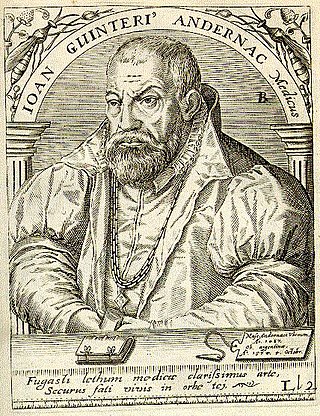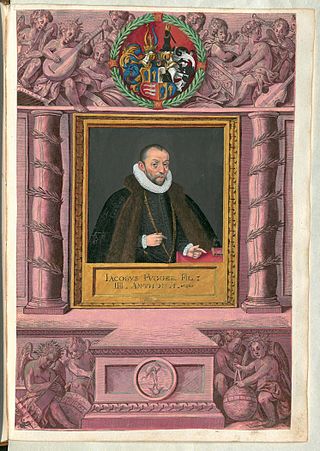
A thermometer is a device that measures temperature or temperature gradient. A thermometer has two important elements: (1) a temperature sensor in which some change occurs with a change in temperature; and (2) some means of converting this change into a numerical value. Thermometers are widely used in technology and industry to monitor processes, in meteorology, in medicine, and in scientific research.
This is a timeline of temperature and pressure measurement technology or the history of temperature measurement and pressure measurement technology.

The Heidelberg Catechism (1563), one of the Three Forms of Unity, is a Reformed catechism taking the form of a series of questions and answers, for use in teaching Reformed Christian doctrine. It was published in 1563 in Heidelberg, Germany. Its original title translates to Catechism, or Christian Instruction, according to the Usages of the Churches and Schools of the Electoral Palatinate. Commissioned by the prince-elector of the Electoral Palatinate, it is sometimes referred to as the 'Palatinate Catechism.' It has been translated into many languages and is regarded as one of the most influential of the Reformed catechisms. Today, the Catechism is 'probably the most frequently read Reformed confessional text worldwide.'

Thomas Erastus was a Swiss physician and Calvinist theologian. He wrote 100 theses in which he argued that the sins committed by Christians should be punished by the State, and that the Church should not withhold sacraments as a form of punishment. They were published in 1589, after his death, with the title Explicatio gravissimae quaestionis. His name was later applied to Erastianism.

Johann Jakob Grynaeus or Gryner was a Swiss Protestant divine.

Frederick III of Simmern, the Pious, Elector Palatine of the Rhine was a ruler from the house of Wittelsbach, specifically the cadet branch of Palatinate-Simmern-Sponheim. He was a son of John II of Simmern and inherited the Palatinate from the childless Elector Otto-Henry, Elector Palatine (Ottheinrich) in 1559. He was a devout convert to Calvinism, and made the Reformed confession the official religion of his domain by overseeing the composition and promulgation of the Heidelberg Catechism. His support of Calvinism gave the German Reformed movement a foothold within the Holy Roman Empire.

Paul Fagius was a Renaissance scholar of Biblical Hebrew and Protestant reformer.

Johannes Piscator was a German Reformed theologian, known as a Bible translator and textbook writer.
Matthias Vehe known as Glirius (c.1545-1590) was a German Protestant religious radical, who converted to a form of Judaism and anti-trinitarianism, rejecting the New Testament as revelation.
Peter Monau was a court physician of Emperor Rudolph II.

Jacob Palaeologus, also called Giacomo da Chio, was a Dominican friar who renounced his religious vows and became an antitrinitarian theologian. A polemicist against both Calvinism and Papal Power, Palaeologus cultivated a wide range of high-placed contacts and correspondents in the imperial, royal, and aristocratic households in Eastern Europe and the Ottoman Empire; while formulating and propagating a radically heterodox version of Christianity, in which Jesus Christ was not to be invoked in worship, and where differences between Christianity, Islam, and Judaism were rejected as spurious fabrications. He was continually pursued by his many enemies, repeatedly escaping through his many covert supporters.

Pierre Boquin was a French Reformed Theologian who played a critical role in the Reformation of the Electoral Palatinate.

Johann Sylvan was a Reformed German theologian who was executed for his heretical Antitrinitarian beliefs.

Johann Winter von Andernach was a German Renaissance physician, university professor, humanist, translator of ancient, mostly medical works, and writer of his own medical, philological and humanities works.
Adam Neuser was a Protestant pastor of Heidelberg who held Antitrinitarian views.
The Bibliotheca dissidentium is a series of 26 volumes (1980–2008) of historical editions of 16th century Non-Conformist religious works, largely in Latin, with scholarly introductions, essays and notations in French, German and/or English published by the Groupe de Recherches sur les Non-Conformismes du XVIe Siècle et l'Histoire des Protestantismes under the general editor, professor André Séguenny of the University of Strasbourg as part of the larger series Bibliotheca bibliographica Aureliana.
Michael Toxites, born Johann Michael Schütz was a doctor, alchemist and poet of the Holy Roman Empire.

Jakob III. Fugger was a German businessman and landowner of the Fugger family. He was also Lord of Schloss Babenhausen in Unterallgäu.

Melchior Sebischthe Elder was a Silesian physician and naturalist. He worked as a professor of medicine at the University of Strasbourg. His only major written work was an edition of the herbals of Tragus published in 1577 with his commentaries. His son Melchior Sebisch II (1578-1674) studied across Europe and also became a professor of medicine at Strasbourg.














